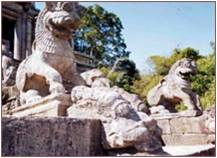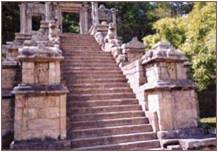Yapahuwa Rock Fortress – ephemeral capital of Sri Lanka
By Arundathie Abeysinghe



Situated about 145 kilometers from Colombo, at the southwestern corner of the Cultural Triangle, Yapahuwa is an ancient rock fortress and capital built in 1301. Rising to a height of about 110 meters above the surrounding low-lying areas, this historical site is situated on the outskirts of Kurunegala. The biggest showpiece of the Rock Fortress is its ornamental stairway, a unique design covered with excellent stone carvings. The top flight of steps of the stairway displays the talented craftsmanship of our ancestors. Originally, there had been three flights of stone stairs. Later, the lowest stair had disappeared and the stone stairs have been replaced with cement stairs.
The steps of this stairway are narrow and need to be maneuvered sideways. According to historians, this may be a form of defense as the steps can neither be ascended nor descended hastily and the forces at the top could arm themselves against an enemy onslaught. There are many traces of ancient battle defenses in this Rock Fortress. According to chronicles, King Bhuwanekabahu I (1273-1284) built his palace on Yapahuwa Rock Fortress. Historians compare Yapahuwa Rock Fortress with Sigiriya Rock Fortress. But Yapahuwa Rock Fortress was built on a much smaller scale.
According to historians, history surrounding Yapahuwa is fascinating. Originally called “Yapawwa”, the Rock Fortress of Yapahuwa was the capital of Sri Lanka for a brief period in the latter part of the 13th century from 1273 to 1284. Yapahuwa had been a military outpost of General Subhapotha (popular as Subha) around 1215 A.D. to defend it against South Indian forces invading south wards. Yapahuwa Rock Fortress was named after Subha, Subhapabbata in Pali and Yapahuwa in Sinhala. When King Bhuwenakabahu I shifted the capital of Sri Lanka from Polonnaruwa to Yapahuwa in 1272 CE (as Yapahuwa was easily defensible from invading foreign forces than Polonnaruwa), he built the Yapahuwa Rock Fortress.
When King Bhuwenakabahu passed away in 1284, Yapahuwa was invaded by *Pandyan Dynasty from Madurai in Southern India. They carried away the *Sacred Tooth Relic to India. This fortress capital of Sinhalese Kings when abandoned had been inhabited by Buddhist monks. During the reign of King Kirti Sri Rajasingha (1747 – 1782) in the 18th century, Yapahuwa was refurbished as a cave temple.
The Sacred Tooth Relic which was taken to South India was brought to Sri Lanka in 1288 A.D. by King Parakramabahu III (1287 – 1293) who temporarily placed it in Polonnaruwa. The Pandyans left Yapahuwa, but in the mid 16th century, the Portuguese marched in. They demolished most of the buildings and Yapahuwa was almost in ruins.
Popular ‘Yapahuwa Lion’ stone sculpture renders memories of Chinese lion figures, the symbol which was printed on Rs. 10 currency note (used as a currency) several years ago in Sri Lanka. In addition to goggle-eyed ‘Yapahuwa Lions’, doors and windows of the Palace have been intricately carved while the panels of the windows are carved with musicians and dancers with a musician playing a Kandyan drum.
The well-planned citadel comprises a rampart as well as two moats. According to historians and archaeologists, the square shaped structures of the rampart suggest that bastions may have existed on it. Exterior fortifications of the Rock Fortress include two ramparts forming a rough semi-circle as well as a moat and the inner fortifications include a high stone wall circled by a moat. Temple of the Sacred Tooth Relic, Royal Palace and administrative buildings had been located within the inner wall, whereas homes of King’s officers had been located between inner and outer walls. To date, there are evidences of these fortifications.
At the summit of the stairway of the Rock Fortress, there is a large stone doorway flanked by thick walls and two exquisitely carved windows. During early excavations, one window was found in fragments while the other Sivumeduru Kawuluwa (perforated palace window) is well preserved. According to scholars, this intricate stone window is elaborately latticed in quasi-Arabian style. At present, this palace window is in the Archaeological Museum situated at the entrance to the Rock Fortress.
A cave temple had been built for monks at the apex. There are remains of a number of buildings in this enclosure. The Sacred Tooth Relic brought from Dambadeniya had been kept in the special chamber in the Rock Fortress.
The first archaeological excavation at Yapahuwa was carried out by H.C.P. Bell, the first Archaeological Commissioner in Sri Lanka (1810 – 1811). According to reports, magnificent types of palace entrances were found by H.C.P. Bell during his excavations.
During recent excavations carried out by Dr. Senarath Dissanayake, Yapahuwa has had pre-historic (from 1,000 B.C. to 500 B.C.) or early historic (from 500 B.C. to 200 A.D.) human settlements and it was the earliest settlement to be found on a rock. According to available evidence, it had been an urban settlement.
The latest archaeological excavations at Yapahuwa reveal that the kingdom had close diplomatic relations with China during the 13th century.
According to archaeologists, during early excavations several Chinese ceramics had been found, the finest ceramics found in Sri Lanka. A large number of celadon pottery parts as well as 12 Chinese coins had been found during the excavations carried out by H.C.P. Bell. This type of good quality porcelain had been made only in China during the Medieval Period. China had used the marine trade route as well as the Silk Route to reach Sri Lanka (former Ceylon) and these ceramics are evidence to trade between Sri Lanka and China in the past.
There is a Cave Temple situated behind the Yapahuwa Museum which comprises wooden Buddha images including a single bronze image. Among the exhibits, there are works of art and *Brahmi inscriptions. The Cave Temple was refurbished in 1886.
Directions: Colombo – Kurunegala – Puttlam Road – Padeniya junction – Daladagama junction – Maho – Morogollagama Road – Yapahuwa
- Buddha Sasana – The Buddha’s doctrine and teaching.
- Sacred Tooth Relic – According to Dathawamsa (also known as Dhatuwansa, a Pali historical chronicle attributed to Dhammakitti Thero (Thero – senior Bhikku), after the *Parinirvana of the Buddha in 543 BC, his sacred body was cremated in a sandalwood pyre at *Kushinagar. *Bhikkuni Khema retrieved the left canine tooth of the Buddha from the funeral pyre and handed it over to King Brahmadatte for veneration. The Sacred Tooth Relic became a royal possession of King Brahmadatte and was kept for veneration in Dantapuri (at present Puri, Odisha). There was a belief that whoever possessed the Sacred Tooth Relic had a right to rule the land. There are records in Dathawamsa of a war 800 years after the passing away of the Buddha, over the Sacred Tooth Relic between King Guhasiva of *Kalinga and a king known as Pandu. Hence, King Guhasiva decided to send the Sacred Tooth Relic to Sri Lanka to protect it. According to Dathawamsa, Princess Hemamala (daughter of King Guhasiva) and Prince Dantha (son-in-law of King Guhasiva) donned garbs of ascetics and carried the Sacred Tooth Relic hidden within the coiffure of Princess Hemamala to hide it from passers-by during their journey to Sri Lanka. When the Sacred Tooth Relic reached the Sri Lankan capital Anuradhapura (Kingdom of Anuradhapura), the Relic was kept in Megha Vihara (Temple) Park. The Sacred Tooth Relic was received by King Kirti Sri Meghavanna (in 4th century AC) and enshrined in the edifice of Dhammacakkageha built by King Devanampiyatissa (306 BC – 266 BC) situated within the Royal Palace Complex. The Sacred Tooth Relic of the Buddha is venerated by Buddhists worldwide. Later, the Sacred Tooth Relic was enshrined in shrines built within the Royal Palace Complex. There are ruins of edifices of such shrines in the ancient capitals of Anuradhapura, Polonnaruwa, Dambadeniya, Yapahuwa, Kurunegala, Kotte and Gampola. At present, the Temple of the Sacred Tooth Relic is situated in Kandy City within the former Royal Palace Complex.
- Parinirvana (Sanskrit) – Passing away of the Buddha or an Arhat (one who has gained insight into the true nature of existence and has achieved Nirvana*).
- Nirvana – Refers to a release from the cycle of death and rebirth, the ultimate spiritual goal of Buddhism.
- Bhikkuni Khema – Bhikkuni (meaning Buddhist nun), Bhikkuni Khema is considered as one of the first chief female disciples of the Buddha along with Bhikkuni Bhikkuni Khema had attained Enlightenment as a laywoman while listening to a sermon delivered by the Buddha, a rare feat for a lay person. After attaining Enlightenment, she entered the monastic life in *Buddha Sasana. The Buddha declared her as the Bhikkhuni foremost in wisdom.
- Brahmi inscriptions – Brahmi (or Brahmin) scripture – The oldest writing system used in Ancient India found in many carvings and rock inscriptions in South and Central Asia including Sri Lanka from the mid first millennium BC.
- Kalinga – Historical state of India. At present, it has been merged largely in Odisha and larger part of Andhra Pradesh to the extent of present day Chhattisgarh (state of east-central India) and Telengana (a state in southern India). The Sacred Tooth Relic was initially preserved in Kalinga after the parinirvana of the Buddha.
- Kushinagar – A town in Uttar Pradesh in India, an important Buddhist pilgrimage site and according to chronicles, the Buddha attained Parinirvana at Kushinagar.
- Pandyans or Pandya Dynasty – Pandyans were Tamil rulers in the extreme south of India. Pandya Dynasty ruled from Madura (at present Madurai – a major city in the Indian State of Tamil Nadu) from early 7th century until 16th








No Comments